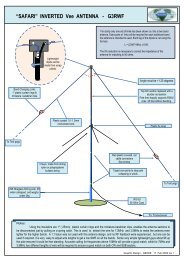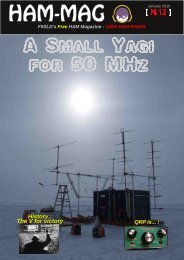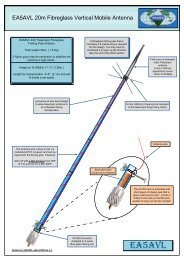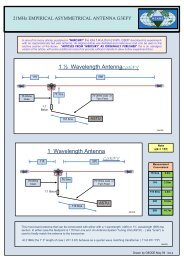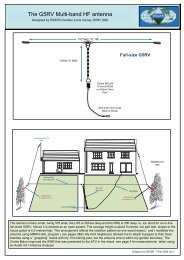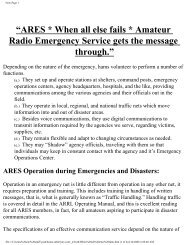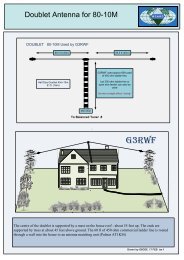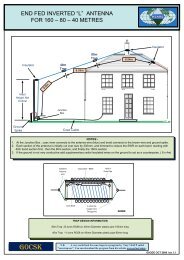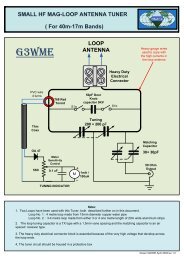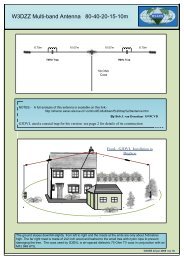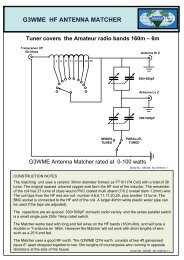Inernational HAM Magazine 100% HAM RADIO - arkansas ares races
Inernational HAM Magazine 100% HAM RADIO - arkansas ares races
Inernational HAM Magazine 100% HAM RADIO - arkansas ares races
You also want an ePaper? Increase the reach of your titles
YUMPU automatically turns print PDFs into web optimized ePapers that Google loves.
Second, in the early 1960s a 1.5 volt scale was added to improve accuracy when measuring smaller<br />
voltages (even a .5 volt scale in some cases). A few models of older VTVM such as the Hewlett<br />
Packard 400 series actually had a vacuum tube in the probe itself. Another limitation is that the test<br />
leads were usually an integral part of the unit—hardwired to the circuitry and not interchangeable.<br />
While these meters can be made fully functional for today’s bench, it is recommended that a more<br />
recent and versatile vintage be selected.<br />
Now that we have a VTVM on the bench, the real question becomes what can we do with it that our<br />
DMM or analog VOM is not capable of? To answer this question let’s first look at how the VTVM works.<br />
In a nutshell, the VTVM uses a dual triode tube (usually a 12AU7) in a balanced bridge circuit to amplify<br />
incoming voltages. This sort of design provides several useful functions. A diagram detailing the most<br />
common VTVM circuitry is shown at the end of this article (RCA WV98A).<br />
The first is that a very high impedance (approximately 10 MΩ) is shown to the circuit under test. This<br />
provides a high degree of isolation between the metering circuit and the test circuit—resulting in a very<br />
low “load” placed into the tested circuit. Such a configuration is very convenient in low power, coupling,<br />
amplifier, and resonant circuits as it does not change the operational characteristics of the circuit. This<br />
characteristic is shared by many quality digital meters.<br />
The measurement of complex sine patterns or other forms such<br />
as square or sawtooth is best accomplished with the VTVM. In<br />
situations where there are likely to be rapid variances and<br />
transient spikes present in the signal, the VTVM shines with its<br />
rapid response and ability to correctly decipher the correct<br />
voltages at hand. This instrument is also relatively immune to<br />
false indications due to interference and strong electromagnetic<br />
fields. It is also much easier to determine the minimum and<br />
maximum changes in a circuit by following the meter needle<br />
than trying to make sense of a wandering digital display. This<br />
alone eases any receiver alignment process.<br />
A high degree of amplification in the metering circuit also means<br />
that very high resistances up to 1000 MΩ can be measured. This<br />
is useful in determining dielectric resistance, leakage of capacitors,<br />
transmission line characteristics, and isolation leakage. The<br />
amplification factor is also beneficial when measuring small audio<br />
or IF voltages, giving one a true indication of the performance of<br />
the circuit under test.<br />
A unique ability that a VTVM has that a DMM or VOM does not is<br />
to read AC voltages in both RMS (rootmeansquare) and PP<br />
(peaktopeak) values. The common DMM/VOM averages the AC<br />
sine wave and delivers an RMS approximation of the voltage. By<br />
using PP voltage measurement, more complex sine waves and<br />
other waveforms can be accurately measured—the added benefit<br />
being that the PP measurement coincides with how an<br />
oscilloscope measures voltage. Combining the VTVM with a<br />
scope delivers waveform observation that sh<strong>ares</strong> the same<br />
measurement standard.<br />
[ <strong>HAM</strong>MAG N.14 March 2010 ]




